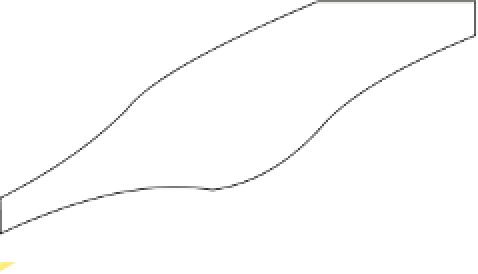Geology Reference
In-Depth Information
Rhyolite
Andesite
Basalt
Granite
Granodiorite
Diorite
Gabbro
Peridotite
100
Potassium
Feldspar
Ca-rich
80
Quartz
60
Na-rich
40
0.1
Biotite
20
0.5
Olivine
1
0
5
75
60
50
40
Silica content (wt.%)
Rock Type
Grain size
Felsic
Intermediate
Mafic
Ultramafic
Fine
<0.25 mm
Medium
0.25-2 mm
Coarse
>2 mm
Basalt
-
Rhyolite
Andesite
Microgranite
Microdiorite
Dolerite
-
Gabbro
Peridotite
Granite
Diorite
Figure 3.10
Preliminary classification scheme for igneous rocks using colour
index (front face shows approximate proportions of light and dark minerals that
occur at different silica contents), common silicate minerals (where recognised
in the field) and grain size (decreasing with depth into the diagram).
combined into a field name for the rock specimen using, initially, Figure 3.10.
Earlier, it was noted that the natural chemical range of most igneous rocks from
40 to 75% SiO
2
is accompanied by a progressive increase in their content of
felsic minerals and a corresponding decrease in their mafic constituents. This
information appears on the front face of Figure 3.10 with the acid, silica-rich
rocks on the left and the ultrabasic rocks on the extreme right.
Although this scheme for preliminary rock identification works well in
the field for medium- and coarse-grained rocks, it is often possible to follow
more closely the precise definitions of the IUGS Subcommission (appendix
Figure A.1). This scheme classifies all rocks with a content of mafic minerals
(plus Fe - Ti oxides, carbonates of igneous origin and accessory minerals) of

































































































































































































































































































